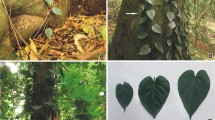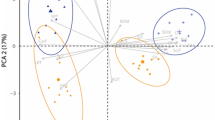Abstract
We investigated the anatomical and physiological characteristics of stenophyllous leaves of a rheophyte, Farfugium japonicum var. luchuence, and sun and shade leaves of a non-rheophyte, F. japonicum, comparing three different populations from coastal, forest floor, and riparian habitats. Light adaptation resulted in smaller leaves, and riparian adaptation resulted in narrower leaves (stenophylly). The light-saturated rate of photosynthesis (P max) per unit leaf area corresponded to the light availability of the habitat. Irrespective of leaf size, the P max per unit leaf mass was similar for sun and shade leaves. However, the P max per mass of stenophyllous leaves was significantly lower than that of sun and shade leaves. This was because the number and size of mesophyll cells were greater than that required for intercellular CO2 diffusion, which resulted in a larger leaf mass per unit leaf area. Higher cell density increases contact between mesophyll cells and enhances leaf toughness. Stenophyllous leaves of the rheophyte are frequently exposed to a strong water flow when the water level rises, suggesting a mechanical constraint caused by physical stress.







Similar content being viewed by others
References
Anderson MC (1964) Studies of the woodland light climate I. The photographic computation of light condition. J Ecol 52:27–41
Balsamo RA, Bauer AM, Davis SD, Rice BM (2003) Leaf biomechanics, morphology, and anatomy of the deciduous mesophyte Prunus serrulata (Rosaceae) and the evergreen sclerophyllous shrub Heteromeles arbutifolia (Rosaceae). Am J Bot 90:72–77
Bragg JG, Westoby M (2002) Leaf size and foraging for light in a sclerophyll woodland. Funct Ecol 16:633–639
Campbell GS, Norman JM (1998) An introduction to environmental biophysics, 2nd edn. Springer, New York
Chazdon RL (1992) Photosynthetic plasticity of two rain forest shrubs across natural gap transect. Oecologia 92:586–595
Choong MF, Lucas PW, Ong JSY, Pereira B, Tan HTW, Turner IM (1992) Leaf fracture toughness and sclerophylly: their correlations and ecological implications. New Phytol 121:597–610
Davies SJ (1998) Photosynthesis of nine pioneer Macaranga species from Borneo in relation to life history. Ecology 79:2292–2308
Esau K (1965) Plant anatomy. Wiley, New York
Evans JR (1989) Partitioning of nitrogen between and within leaves grown under different irradiance. Aust J Plant Physiol 16:533–548
Evans JR, Von Caemmerer S, Setchell BA, Hudson GS (1994) The relationship between CO2 transfer conductance and leaf anatomy in transgenic tobacco with a reduced content of rubisco. Aust J Plant Physiol 21:475–495
Gates DM, Alderfer R, Taylor SE (1968) Leaf temperatures of desert plants. Science 159:994–995
Groom PK, Lamont BB (1997) Xerophytic implications of increased sclerophylly: interactions with water and light in Hakea psilorrhyncha seedlings. New Phytol 136:231–237
Haberlandt G (1914) Physiological plant anatomy. Macmillan, London
Hanba YT, Miyazawa S, Terashima I (1999) The influence of leaf thickness on the CO2 transfer conductance and leaf stable carbon isotope ratio for some evergreen tree species in Japanese warm temperate forests. Funct Ecol 13:632–639
Hikosaka K (2004) Interspecific difference in the photosynthesis—nitrogen relationship: patterns, physiological causes, and ecological importance. J Plant Res 117:481–494
Honda SI, Hongladoram-Honda T, Kwanyuen P, Wildman SG (1971) Interpretations on chloroplast reproduction derived from correlations between cells and chloroplasts. Planta 97:1–15
Imaichi R, Kato M (1992) Comparative leaf development of Osmunda lancea and O. japonica (Osmundaceae): heterochronic origin of rheophytic stenophylly. Bot Mag Tokyo 105:199–213
Kato M, Imaichi R (1992) A broad-leaved variant of the fern rheophyte, Tectaria lobbii. Int J Plant Sci 153:212–216
Kitamura S (1981) Compositae. In: Satake Y, Ohwi J, Kitamura S, Watari S, Tominari T (ed) Wild flowers of Japan: Heabaceous plants III (including dwarf subshrubs) (in Japanese). Heibonsha, Tokyo, pp 156–235
Knight CA, Ackerly DD (2003) Evolution and plasticity of photosynthetic thermal tolerance, specific leaf area and leaf size: congeneric species from desert and coastal environments. New Phytol 160:337–347
Montgomery R (2004) Relative importance of photosynthetic physiology and biomass allocation for tree seedling growth across a broad light gradient. Tree Physiol 24:115–167
Nevo E, Bolshakova MA, Martyn GI, Musatenko LI, Sytnik KM (2000) Drought and light anatomical adaptative leaf strategies in three woody species caused by microclimatic selection at “Evolution canyon”, Israel. Isr J Plant Sci 48:33–46
Niinemets Ü (1999) Components of leaf dry mass per area—thickness and density—alter leaf photosynthetic capacity in reverse directions in woody plants. New Phytol 144:35–47
Nobel PS (1977) Internal leaf area and CO2 resistance: photosynthetic implications of variations with growth conditions and plant species. Physiol Plant 40:137–144
Oguchi R, Hikosaka K, Hirose T (2003) Does the photosynthetic light acclimation need change in leaf anatomy? Plant Cell Environ 26:505–512
Onoda Y, Hikosaka K, Hirose T (2004) Allocation of nitrogen to cell walls decreases photosynthetic nitrogen-use efficiency. Funct Ecol 18:419–425
Poorter H, Remkes C, Lambers H (1990) Carbon and nitrogen economy of 24 wild species differing in relative growth rate. Plant Physiol 94:621–627
Pyke KA (1999) Plastid division and development. Plant Cell 11:549–556
Read J, Sanson GD (2003) Characterising sclerophylly: the mechanical properties of a diverse range of leaf types. New Phytol 160:81–99
Reich PB, Walters MB, Ellsworth DS (1992) Leaf life-span in relation to leaf, plant, and stand characteristics among diverse ecosystems. Ecol Mono 62:365–392
Setoguchi H, Kajimaru G (2004) Leaf morphology of the rheophyte, Rhododendron indicum f. otakumi (Ericaceae). Acta Phytotax Geobot 55:45–54
Slaton MR, Smith WK (2002) Mesophyll architecture and cell exposure to intercellular air space in alpine, desert, and forest species. Int J Plant Sci 163:937–948
Smith WK (1978) Temperatures of desert plants: another perspective on the adaptability of leaf size. Science 201:614–616
Terashima I, Evans JR (1988) Effects of light and nitrogen nutrition on the organization of the photosynthetic apparatus in spinach. Plant Cell Physiol 29:143–155
Terashima I, Hikosaka K (1995) Comparative ecophysiology of leaf and canopy photosynthesis. Plant Cell Environ 18:1111–1128
Terashima I, Miyazawa S, Hanba YT (2001) Why are sun leaves thicker than shade leaves? Consideration based on analyses of CO2 diffusion in the leaf. J Plant Res 114:93–105
Terashima I, Araya T, Miyazawa S, Sone K, Yano S (2005) Construction and maintenance of the optimal photosynthetic systems of the leaf, herbaceous plant and tree: an eco-developmental treatise. Ann Bot 95:507–519
Thain JF (1983) Curvature correlation factors in the measurements of cell surface areas in plant tissues. J Exp Bot 34:87–94
Thomas JF, Harvey CN (1983) Leaf anatomy of four species grown under continuous CO2 enrichment. Bot Gaz 144:303–309
Tsukaya H (2002) The leaf index: heteroblasty, natural variation and the genetic control of polar processes of leaf expansion. Plant Cell Physiol 43:372–378
Tsukaya H (2005) Leaf shape: genetic controls and environmental factors. Int J Dev Biol 49:547–555
Usukura M, Imaichi R, Kato M (1994) Leaf morphology of a facultative rheophyte, Farfugium japonicum var. luchuense (Compositae). J Plant Res 107:263–267
van Steenis CGGJ (1981) Rheophytes of the world. Sijthoff & Noordhoff, Alpen aan den Rijn
Wright IJ, Westoby M (2002) Leaves at low versus high rainfall: coordination of structure, lifespan and physiology. New Phytol 155:403–416
Yahara T (1996) Floral sex: evolutionary approaches (in Japanese). University Tokyo Press, Tokyo
Yano S, Terashima I (2004) Developmental process of sun and shade leaves in Chenopidium album L. Pl Cell Environ 27:781–793
Yokota M (2003) Vascular plants. In: Nishida N, Shibatani N, Shokita S (ed) The flora and fauna of inland waters in the Ryukyu Islands (in Japanese). Tokai University Press, Hadano, pp 99–114
Acknowledgments
We thank K. Yasuda for suggestions and support in the field; H. Omukai for skillful factory work; and K. Kikuzawa, Y.T. Hanba, M. Yokota, M. Yamazaki, Y. Miyazawa, Y. Shimamoto, H. Goto, M. Ishihara, A. Kimura, F. Sakuma, H. Taira, K. Fuketa, and Y. Kimoto for kind support and comments. This study was performed as a part of the research project “Interactions between Natural Environment and Human Society Systems in Subtropical Islands” at the Research Institute for Humanity and Nature (RIHN).
Author information
Authors and Affiliations
Corresponding author
Rights and permissions
About this article
Cite this article
Nomura, N., Setoguchi, H. & Takaso, T. Functional consequences of stenophylly for leaf productivity: comparison of the anatomy and physiology of a rheophyte, Farfugium japonicum var. luchuence, and a related non-rheophyte, F. japonicum (Asteraceae). J Plant Res 119, 645–656 (2006). https://doi.org/10.1007/s10265-006-0024-5
Received:
Accepted:
Published:
Issue Date:
DOI: https://doi.org/10.1007/s10265-006-0024-5




